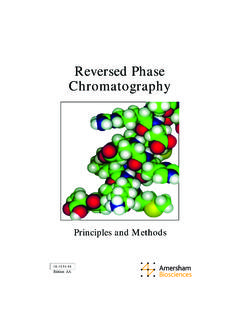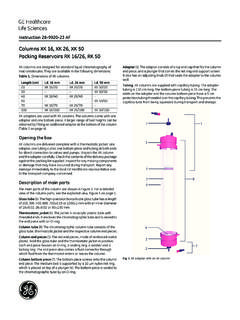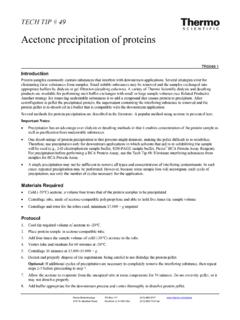Transcription of ProteoExtract Protein Precipitation Kit Cat. No. 539180
1 Size 1 kit Form 200 Precipitations. Storage Upon arrival, all components of the kit can be stored at room temperature (20 C). For ease of use, the prepared Precipitation Agent and the Wash Solution can be stored at -20 C (see Reagent Preparation). Intended Use The ProteoExtract Protein Precipitation Kit is designed for the concentration and clean-up of proteins from aqueous samples. Background Proteomics sample analysis is often hampered by the presence of non- Protein impurities such as buffers, salts, and detergents that interfere with electrophoretic seperations or enzymatic digestion.
2 Additionally, proteins in solution are often too dilute for direct downstream applications. Precipitation of proteins is procedure that can both concentrate proteins and remove interfering substances in one step. Principle of the Assay The ProteoExtract Protein Precipitation Kit provides a fast and efficient method for concentrating and cleaning up proteins from a variety of sources. Detergents, chaotropic buffer components, salts, and other interfering compounds remain in the solution, while proteins are precipitated. Precipitated proteins can easily be re-suspended in the buffer of choice for a wide range downstream applications, such as isoelectric focusing (IEF), 2 DGE, and 1 DGE, or for tryptic digestion prior to mass spectrometry and peptide separation.
3 The kit can be used with virtually any aqueous Protein sample with a Protein concentration ranging from 50 g/ml to 10 mg/ml. Sample recovery is consistently higher then 90%. One kit is sufficient for the concentration and clean-up of 200 samples of 200 l each. The procedure is scalable with sample volumes smaller or larger than ml can be processed. The ProteoExtract ; Protein Precipitation Kit yields Protein solutions with very low conductivity compared to standard Protein Precipitation methods, making them ideally suited for isoelectric focusing (IEF), 2 DGE, and 1 DGE. The procedure does not result in selective loss of small proteins or changes in Protein pattern relative to the untreated samples.
4 ProteoExtract precipitated proteins are fully compatible with mass spectrometry (MS) following 2 DGE separation as demonstrated by Protein Precipitation after removal of abundant proteins from human serum as model experiment. User Protocol 539180 Rev. 12-October-06 JSWP roteoExtract Protein Precipitation Kit Cat. No. 539180 Note that this user protocol is not lot-specific and is representative of the current specifications for this product. Please consult the vial label and the certificate of analysis for information on specific lots. Also note that shipping conditions may differ from storage conditions.
5 Full details are available at Materials Provided There are sufficient reagents to process 200 samples of 200 l each. Precipitant 1*: 5 bottles; 29 ml each Precipitant 2: 1 bottle, 10 ml Precipitant 3: 1 bottle, 10 ml Precipitant 4: 1 bottle, 10 ml Wash Solution*: 1 bottle, 65 ml *Precipitant 1 and the Wash Solution need to be reconstituted as described in the Reagent Preparation section. Materials Required but not Provided Ethanol Microcentrifuge Micropipettes and tips, 10 l, 200 l and 1 ml size Precautions and Recommendations 1. Always place the centrifuge tube in the centrifuge in the same orientation during the entire procedure so that the pellet remains on the same side of the tube after each centrifugation.
6 This will minimize loss of Protein pellets during centrifugation and washing. 2. The protocol can be applied to any volume, but optimization is required for Protein Precipitation from samples larger or smaller than 200 l. Figure 1: Conductivity Following Protein Precipitation The ProteoExtract Protein Precipitation Kit yields Protein samples with significantly lower conductivity then other Precipitation methods. Proteins at a concentration of 1 mg/ml were precipitated from 1 M sodium chloride solutions according to the Detailed Protocol. The same experiment was performed using standard protocols as TCA/DOC or acetone Precipitation .
7 Protein pellets were solubilized in IEF buffer for conductivity measurement. Sample Preparation Samples: The assay will precipitate proteins from a broad range of sample types containing from 50 g/ml to 10 mg/ml Protein . The assay will tolerate chaotropes ( , UREA) to to a concentration of 8 M, detergents up to 4%, and salts up to 2 M. Reagent Preparation Note: Prior to using the kit for the first time, the Precipitation Agent and the Wash Solution must be prepared and chilled to -20 C. Precipitation Agent: 1. To one bottle Precipitant 1 add ml Precipitant 2, ml Precipitant 3, and ml Precipitant 4; mix well.
8 2. The mixture of Precipitant 1, 2, 3, and 4 is called the Precipitation Agent. One bottle Precipitation Agent ( ) is sufficient for Precipitation of 40 samples of 200 l each. 3. Label the Precipitant 1 bottle after reconstitution for easy recognition. For ease of use, store the Precipitation Agent at -20 C; reconstituted Precipitation Agent is stable for up to 2 months. Wash Solution: 1. Add 150 ml high quality ethanol (not provided) to the bottle of Wash Solution (denatured ethanol may also be used). 2. Mix well and store at -20 C. Reconstituted Wash Solutions is stable for up to 1 year.
9 Note: Each 200 l sample requires 800 l Precipitation Agent and 1 ml Wash Solution. Detailed Protocol Note: The following protocols have been successfully used to precipitate and re-solubilize proteins from samples with a concentration range of 50 g/ml to 10 mg/ml. Protocol for Protein Precipitation from 200 l Samples 1. In a microcentrifuge tube with conical bottom, mix 200 l sample with 800 l cold Precipitation Agent (-20 C). Vortex briefly. 2. Incubate for 20-60 min at -20 C. Longer incubation times will not affect the Precipitation . Note: A 60-min incubation period is recommended for very dilute samples.
10 3. Centrifute the sample for 10 min at room temperature, 10,000 g (14,000 rpm) to pellet the proteins. 4. Carefully aspirate the supernatant completely without disturbing the pellet. Note: The pellet may be loose at this stage. 5. Wash the pellet by adding 500 l cold Wash Solution (-20 C) and vortex briefly. 6. Centrifuge for 2 min at room temperature, 10,000 g (14,000 rpm) to pellet the proteins. Carefully aspirate the Wash Solution completely without disturbing the pellet. 7. Repeat steps 5 and 6. 8. Dry the pellet for 5 min to 1 h at room temperature by leaving the open tube on the lab bench (Note: the drying time will depend on the downstream application).


















